Monarchs are mythical and mysterious. I wanted more butterflies in our garden. I love planting native flowers, trees and bushes. For those reasons, I planted milkweed. My plan worked. The milkweed took off! We had many monarchs in our yard!
I started finding caterpillars. Then they’d disappear. It worried me. Never mind that fossil records indicate that these delicate creatures have been on our planet for 200 million years. They needed me to survive! Little did I know what I was in for.
MONARCHS ARE MYTHICAL AND MYSTERIOUS.... YET THEY NEEDED ME
You’re undoubtedly familiar with the iconic orange and black of the monarch butterfly. These lovely lepidoptera are classified as insects. They have amazing adaptations, a unique life cycle, and kick butt with their migration patterns, some flying as far as 2500 miles to reach the remote treetops of Mexico. But they needed me to save them.
Joking aside, I learned a sobering fact:
ONLY FIVE PERCENT OF MONARCH EGGS SURVIVE TO BECOME BUTTERFLIES
ANOTHER WAY OF LOOKING AT IT : 95% MONARCH MORTALITY RATE
They did need Louie and me to save them!
We brought a few caterpillars inside. I fed them with milkweed. There was a learning curve. (boo)
Monarch eggs and caterpillars have enemies.
PREDATORS AND PARASITES
Mother nature is not kind to eggs and caterpillars. Monarchs face many predators and parasites.
Tachnid flies lay eggs inside caterpillars, which is pretty gross and horrible when they hatch. (Like that old move Alien)
Wasps and ants eat them.
Spiders eat them.
Don’t even get me started on the OE spores. (Ophryocystis elektroscirrha is a protozoan parasite that infects the Monarch world-wide) Their life cycle has synced to a monarch life cycle.
This is an example of symbiosis, with the relationship harming one of the pair involved.
This is Ozzie on the left, our bearded dragon. Not an alien or protozoan parasite. He is a predator and eats insects.
He also likes blueberries and sweet potatoes, which I’m sure bearded dragons find regularly in their indigenous habitat in the Australian Outback.
This is as close as I felt like going w/ photos of predators for this post.
And there’s man, too. Eggs and caterpillars are extremely sensitive to pesticides, even to flea and tick medicine on your pet. Not to mention mowing down milkweed too soon, before all the caterpillars are done eating, completing their metamorphosis, and the butterflies are ready to fly south.
MONARCHS AND MILKWEED : A SYMBIOTIC RELATIONSHIP
Monarchs and milkweed have a close association! It’s also considered a symbiotic relationship. Milkweed is poisonous. Most insects and birds avoid milkweed and caterpillars. (But not all, of course.)
WHAT DO MONARCH CATERPILLARS EAT?
MILKWEED!
The milkweed flowers are great for all pollinators, though! Only the leaves are poisonous.
Planting milkweed will help not only monarchs, but all our pollinators.
HUNTING FOR EGGS
It took me a few days to figure out how to even find eggs. It sounds easy but it wasn’t, not at first. The mama monarch usually lays eggs on the underside of the leaf. It’s tricky to carefully tilt the stalk over and look for them.
There are three eggs on the right. Can you find them? Okay, of course you can but my point is that they are tiny!
By the way, scientific name for monarch butterflies is Danaus Plexippus.
EGGS HATCH IN 3-5 DAYS
In 3-5 days, the eggs hatch! I put mine on a paper towel in a covered container, opening it a few times a day for fresh air. (It’s not like they’re going to run away or suffocate in minutes.) In the photo below, the black spots are the caterpillars’ heads.
Video below of a tiny caterpillar. (Instar one, which means just born) This cat is so small, it’s hard to believe any of them survive.
The first thing they do is eat their shell. Mother Nature is so clever. They are born blind and barely know day from night.
The caterpillars eat and eat and eat, hence becoming poisonous themselves, like the milkweed. Most predators avoid them! Sadly, predators need to take a taste before they learn.
Poor caterpillars!
After some trial and error, my eggs hatched and the cats kept eating!
I washed and washed the leaves and they ate and ate and ate. I was a caterpillar slave!
CATERPILLARS MOLT!
I’ve always found animals that molting skin all at once simultaneously disgusting and intriguing. This is part of the monarch mystique.
Caterpillars shed their skin every few days. It takes 10-12 days of constant eating, with five molts to get from instar one to instar five, which means they are ready to form their chrysalis. And based on the numbering system– Instar one to instar five–you can guess that there are five molts.
After 10-12 days and five molts, the caterpillar has enough energy stored.
Time to form a chrysalis! Talk about mythical and mysterious.
Butterflies do NOT form a cocoon
Butterflies form a chrysalis
CHRYSALIS FORMATION
The caterpillar finds a safe location and hangs by forming a strong silk button.
Okay, in my dining room, they were safe no matter what but you get the idea!
It has a huge job ahead. They need to actually split their backs open and shed their skin for the last time. But this time is different. Under their skin is a jade green casing. This is the chrysalis.
On the right in the foreground, you can see a partially formed chrysalis. The black is her skin, which falls off.
Instar five cats can crawl over 30 feet to find the right spot to pupate.
INSIDE THE CHRYSALIS
This part of the monarch life cycle gets the prize for mythical and mysterious.
ECLOSING!
In 10 days, a butterfly emerges. It takes about five seconds. Believe me! I missed my first girl eclosing! (emerging from the chrysalis)
When the chrysalis becomes transparent and you can see the wings, you know it’s time!
So what did I do? Decide I had time to take Louie for a walk.
It takes four hours for the new butterfly wings to dry. They are exceptionally vulnerable to predators at this time, as you can imagine!
They don’t eat for 24 hours so if the weather isn’t optimal, one can hold off releasing them!
Then they can be released and are able to fly! ! A newly emerged Monarch uses its straw-like tongue, called a proboscis, to sip nectar. I managed to get a video. (see below)
MONARCH LIFE CYCLE TIMELINE = METAMORPHOSIS
The monarch life cycle is technically called metamorphosis. There are four stages, which I’m sure you’ve already surmised! But this is a science blog so I’m going to summarize here.
It takes 28-32 days to complete the stages for an egg to become a butterfly!
Factors such as heat, sunlight, humidity all play a part.
This lasts 3-5 days.
Newborn cat often eats their shell casing.
This is the caterpillar stage. (caterpillar sounds better than larva!)
This is when the caterpillar forms its chrysalis.
A lot is going on inside this hard shell! In 10 days, a butterfly will emerge. This is called eclosing, and takes about five seconds!
It really is that fast, believe me. I missed my first girl eclosing. Okay, I said that already…
Monarchs only live about two weeks. In five days they are sexually mature. They mate. Females lay over 100-300 eggs in their lifetimes.
MONARCH MIGRATION : THE SUPER GENERATION
They need to expend their energy on flight! They fly up to FIFTY miles a day.
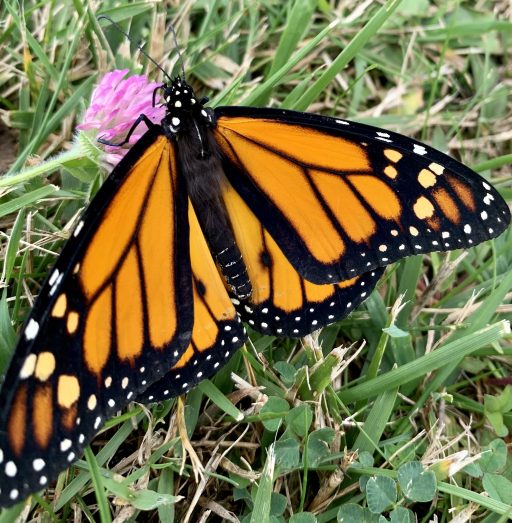 Obviously, to make the trip to Mexico. Monarchs from Canada fly 2500-3000 miles!
Obviously, to make the trip to Mexico. Monarchs from Canada fly 2500-3000 miles!
No reproducing in Mexico. They return to the places they left and mate in spring.
MONARCH POPULATIONS ARE DWINDLING
Scientists study this, spend time tagging and counting. Populations are dwindling. Maybe you don’t want to raise caterpillars, but you can help monarch populations!
Plant milkweed! This provides monarchs with more options for a critically needed habitat. This is huge and will help population decline.
There are many pretty varieties of milkweed. Butterfly weed counts, too! And plant pollinator plants, so they have readily available food!
Butterflies are cold-blooded. They need flowers in the sun!
HOW TO TELL MALES FROM FEMALES
It’s possible to tell a male from female after they form their chrysalis, but I didn’t want to bother them. Besides, it’s fun to have the surprise!
Males monarchs have two dots on their wings. Females do not. (see pics below!)
I started raising caterpillars quite late in the season. I proudly helped four eggs become butterflies. (Three girls and a boy!)
HUZZAH!
People get VERY good at it…
Kidding aside, I’m sure you’ll agree; monarchs are mythical and mysterious!
DON'T MISS OUT ON THE COOL SCIENCE! SUBSCRIBE!
HT Mega Addons

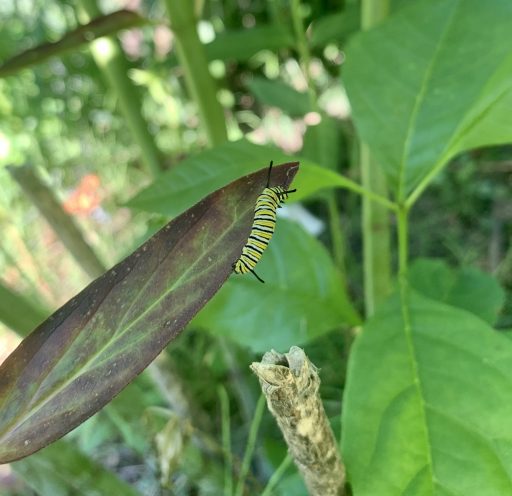
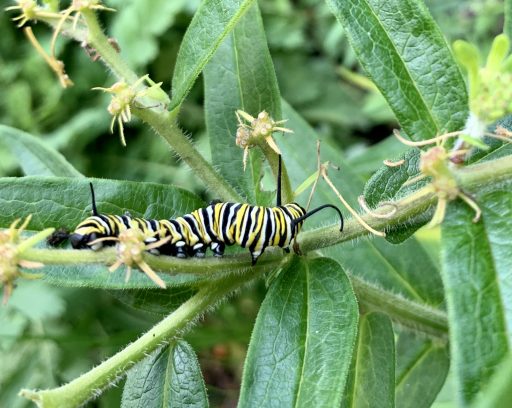
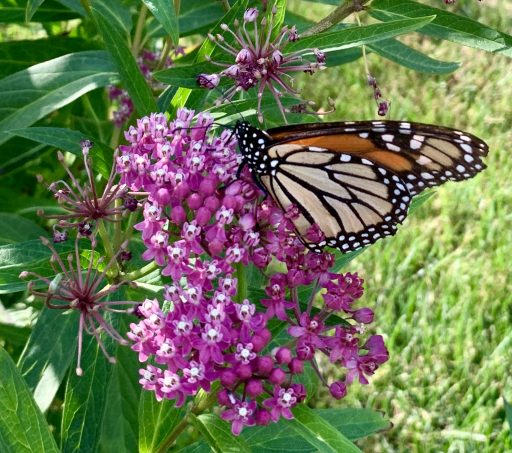
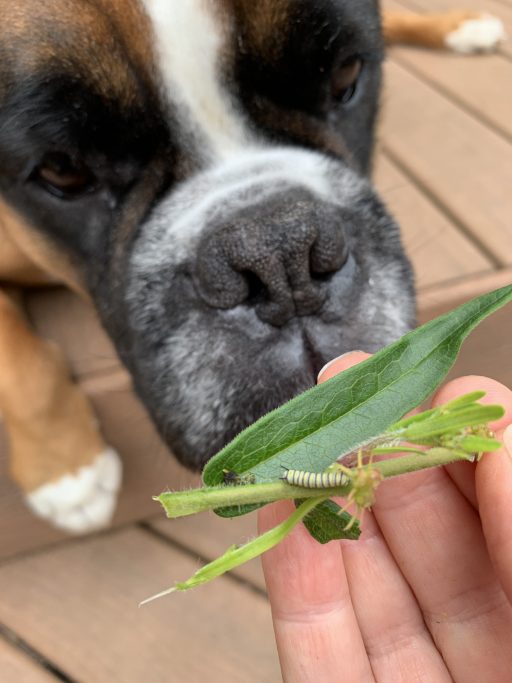
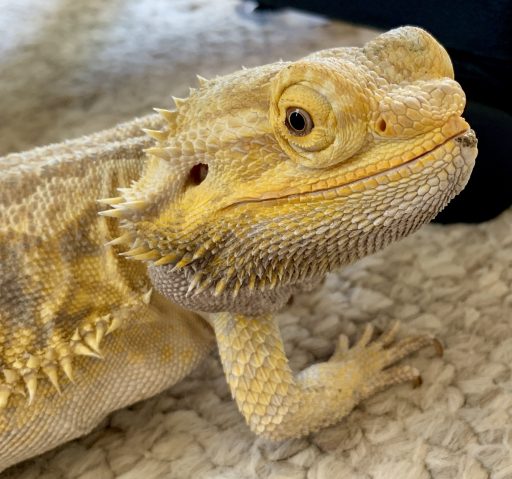
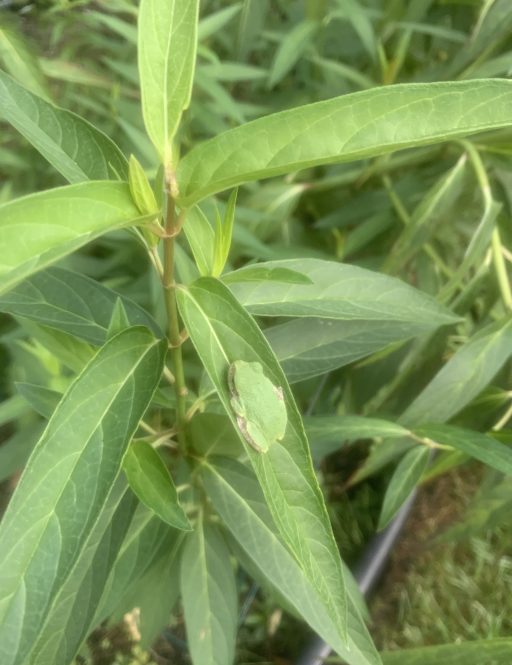

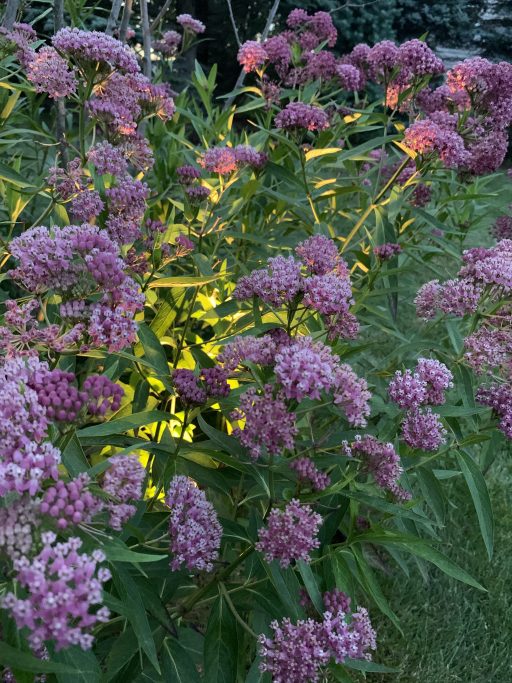
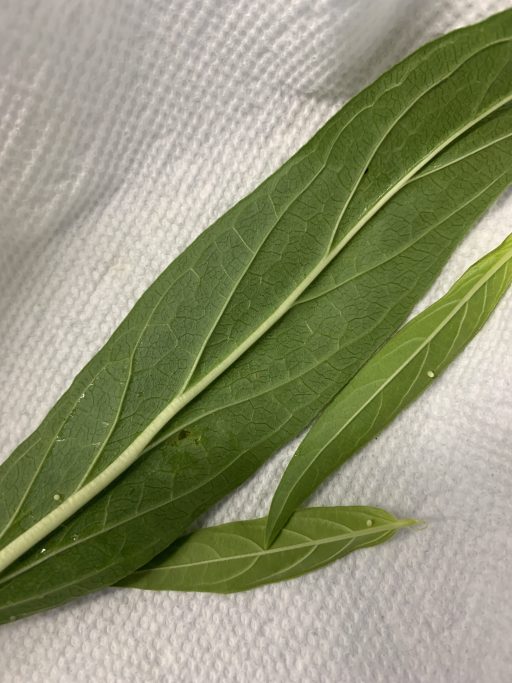
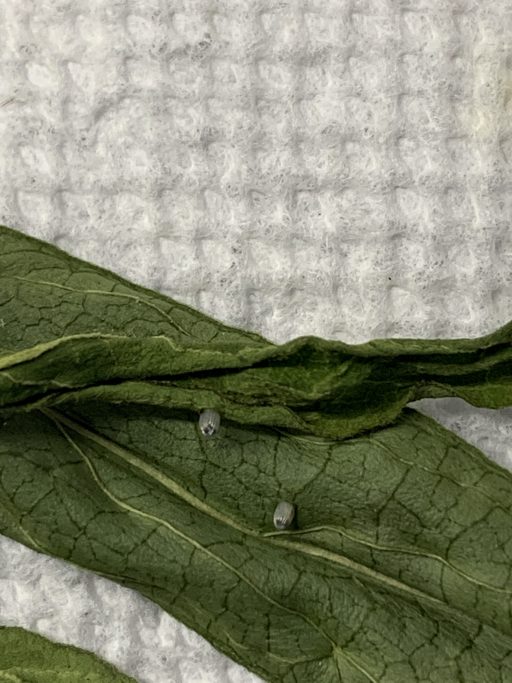
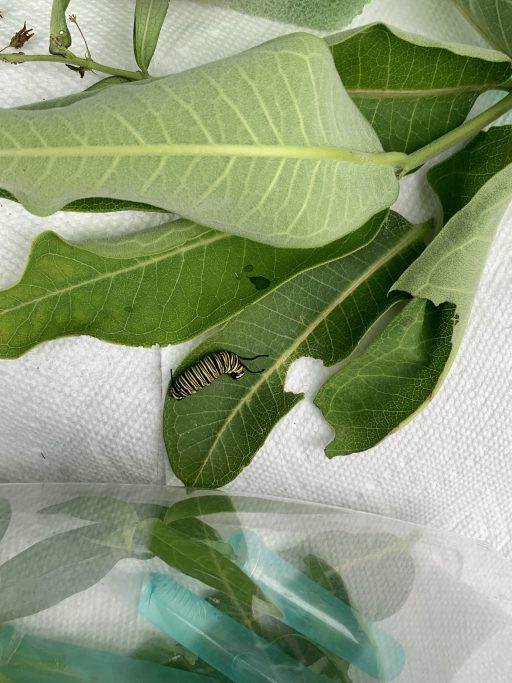
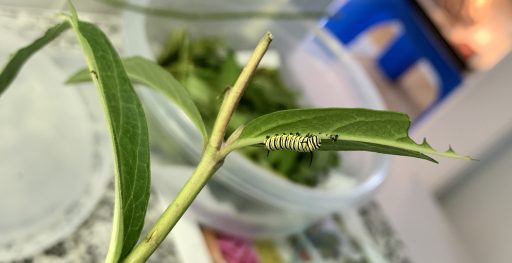
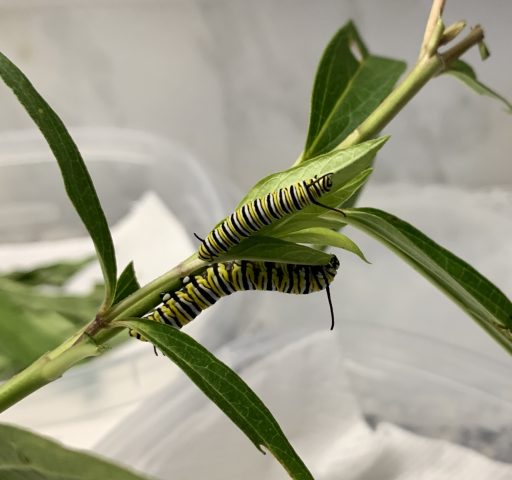
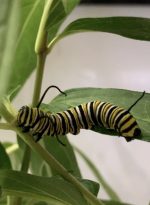
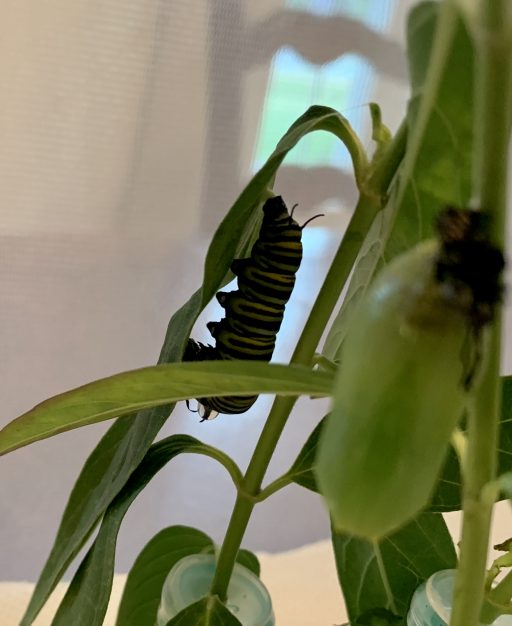
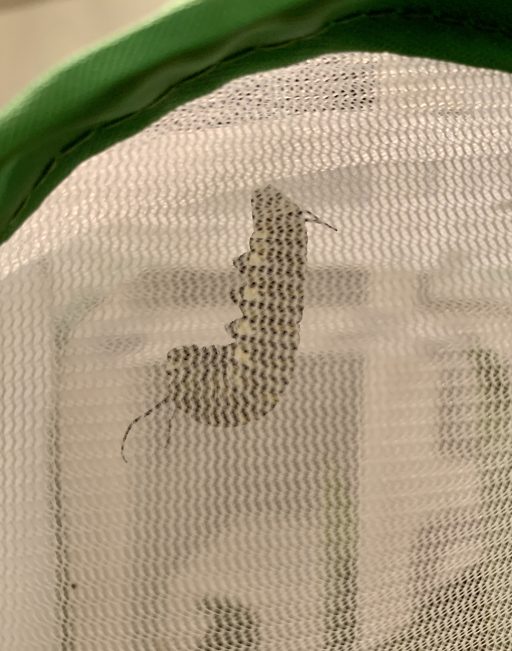
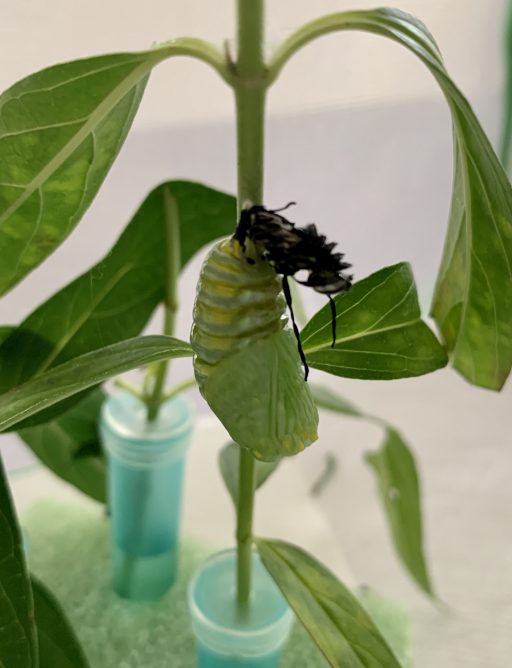


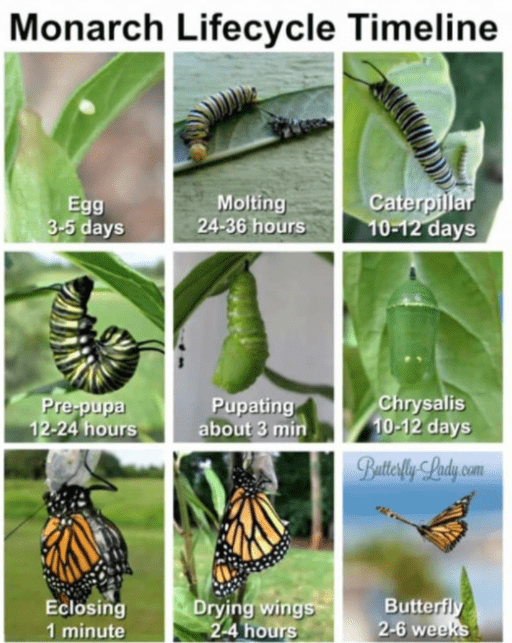
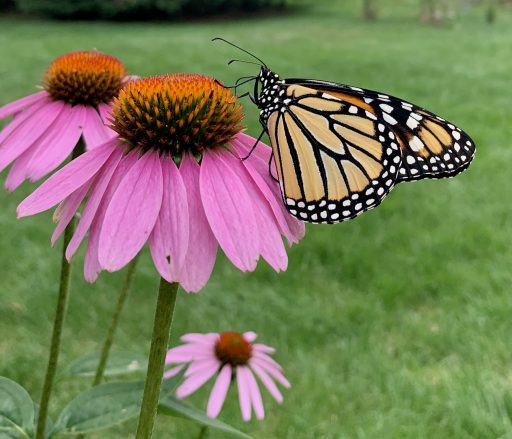
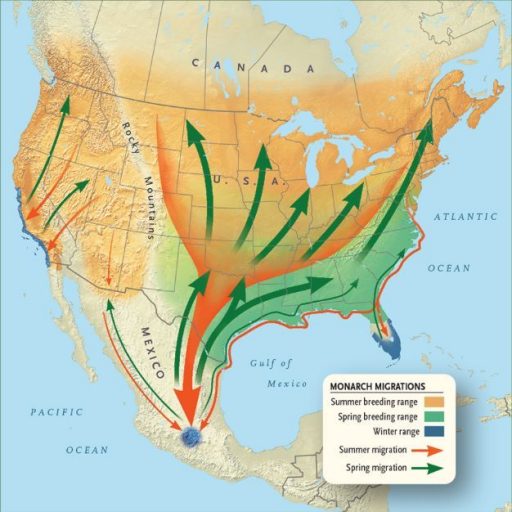
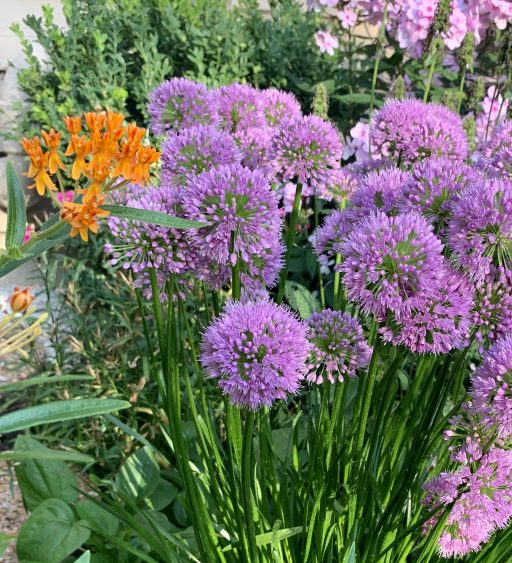
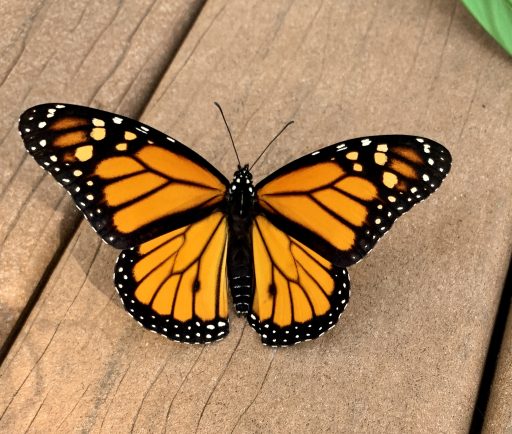
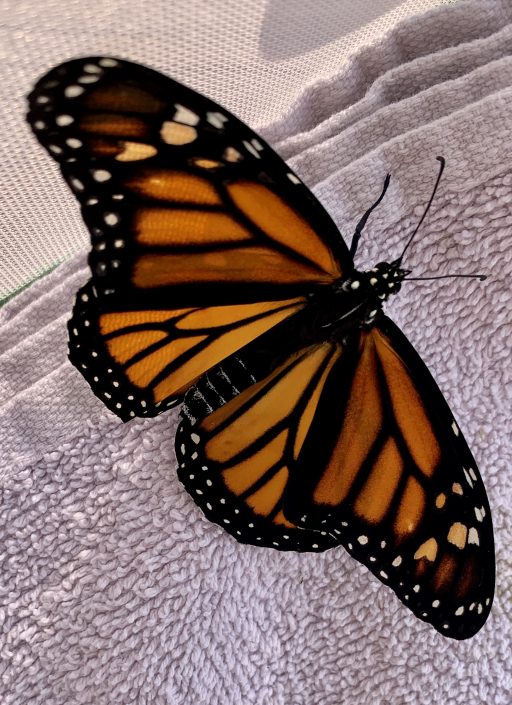
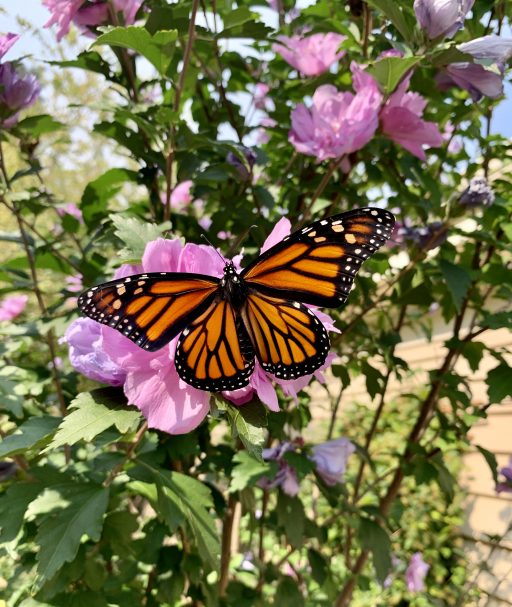
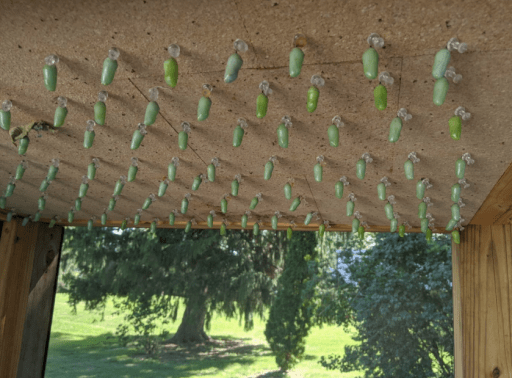

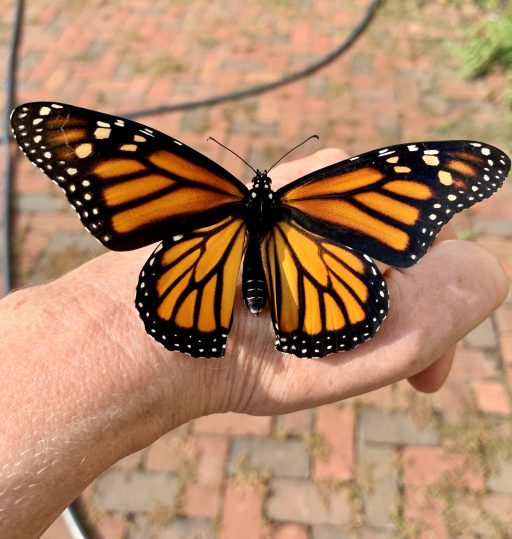




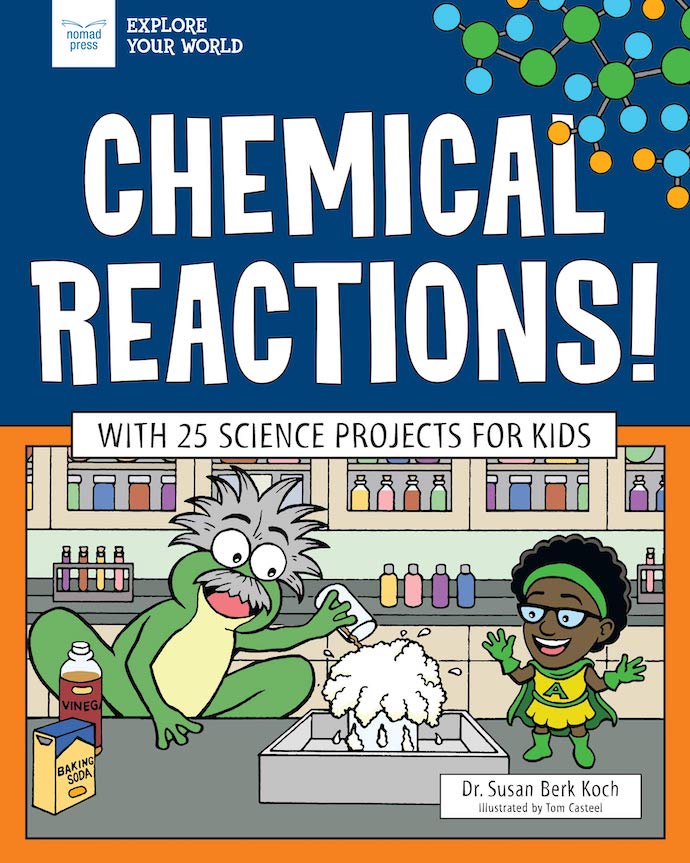



I love butterflies and found this blog so very interesting . Even after going to the Butterfly House here in St.Louis I did not got as much info about butterflies and their lives as I did from your blog. Wish I had the garden to raise Monarchs!!
All you need is to plant some swamp milkweed or butterfly weed and poof! You’ll have it! Thanks so much.
If they have such a short life cycle, how does the population sustain itself throughout the year?
The migration generation lives for about nine months, down in Mexico and including the migration to and from. So they have about three months to reproduce. I’m speaking from southern Wisconsin, so our monarchs need leave before the third week in September. Southern states, the migration begins later. Cities in, say Texas, monarchs may not leave until late October. There are more generations to keep reproducing.
Here’s a cool web page that will tell you when the monarchs migrate, by latitude. (Maybe I should add it to the post) https://monarchwatch.org/tagmig/peak.html
The females lay 100-300 eggs in their lifetime. So we need a lot of monarch mamas, because of the eggs’ low survival rate! And a lot of milkweed, to lay the eggs. Pollinators, to keep them well fed. Do you still have monarchs in your area?
No idea if my area does, I live in London and rarely spend time in any of London’s parks and green spaces
I’d love to go to London someday! Like mine, your butterflies would be heading south by now, too. Maybe give the park a go? Take a few pics for me! Anyway, thanks again.
I love monarch butterflies. We always get a few in our yard, but is love to get a patch of milkweed going to support them. Hopefully next year!
That would be fantastic! You’d see more monarchs and be helping their species. Thanks!
Monarch butterflies are sooo pretty. I’ve never seen them in real life as I don’t think they’re native to my country but I see them lots in illustrations as their colours are very beautiful.
🌿 Marissa Belle × marsybun.com 🌿
I agree, monarchs are beautiful! I’m going to investigate indigenous animals in Singapore! I’d love to go there someday. Thanks, Marissa!
Good read! I didn’t know many things about the monarch’s life cycle. Beautiful photos too!
It was an edifying activity, without question. Thank you!
Wow that’s amazing! Well done for being able to do it! I would definitely not have been able to do it!
I bet you could be a monarch mom! Even if you don’t want to take the plunge, plant some milkweed next spring. Watering is easier! Ha Thanks.
Haha!
This was really interesting! We did a butterfly growing kit with the kids a few months ago, and they had so much fun. Our 5 year old is obsessed with butterflies.
A friend told me that she did the same–used a kit– with swallowtails. That may be easier…! Your five-year-old sounds sweet. Thanks!
This post brought me back to my childhood days when I ran behind all the butterflies and tried to catch them! An awesome post Susan, really detailed and I learned some fun new facts 🙂
Thanks so much, Dennis! I appreciate it.
A very interesting and fact filled post. I must admit that I knew virtually about monarchs before reading this post (other than they are mythical and mysterious). I need to plant milkweed for sure. Thanks for this,
Mythical and mysterious, indeed! Thanks so much!
Wow, I enjoyed reading this post! It’s amazing and very informational. Love the pictures too! Great post, thanks for sharing this! 😄💕
I’m happy you enjoyed it. Thanks!
We get lots of butterflies in our garden, which is always a nice sight.
Love the bearded dragon, the kids love to go and see their mums cousins dragon, and find it fascinating 😊
Believe it or not, I’ve had this guy for 15 years! He’s super tame and sweet. Nice that you’ve got tons of butterflies. Thanks!
We don’t have any Monarchs in our garden but we are plagued by Cabbage Whites whose caterpillars eat all my broccoli 🙁 But we also have some other varieties too, which are very pretty to look at and love our buddleias. Fascinating post, Sue, thank you!
Oh no, your broccoli? I assume you’ve covered it with mesh to try to stop them? Leave them one plant? Swallowtails eat parsley, but it’s tougher to share the broccoli. At least monarchs eat leaves that we don’t. Thanks, Lisa!
I really enjoyed reading this post! It’s quite fascinating to see how quickly they change. I have always planted plants which are butterfly and hummingbird friendly. We all need to take responsibility to protect butterflies!
We sure do! I’m excited that you’re already helping the pollinators! Thanks so much.
Cool post!! I love Monarchs. We have been to the Monarch Butterfly Sanctuary in Pacific Grove which is on their yearly migration path. It’s amazing. Now I need to figure out if milkweed will grow here .
How cool that you were able to see a migration! If you’ve got a patch of sun, I get you can make it work. Swamp milkweed is prettier than the standard variety. Thanks!
This is such an interesting post! I don’t know much about butterflies or caterpillars, so it was nice to read through and learn. Especially with it comes to the monarch, so beautiful! Brilliant read.
Anika | chaptersofmay.com
Thank you! I’m happy your found my post informative. Monarchs are beautiful!
I absolutely love this Susan! I’ve always had a thing for insects, ever since I was a little girl. In fact, I worked in an entomology lab in college for 3+ years. There I researched the hormonal control metamorphosis in the manduca sexta (tobacco hornworm, which becomes a moth). Your pictures are beautiful. I hope to see the monarch migration down in mexican someday. Thank you!
Interesting! I think the hornworm is what got to our tomato plants one year. I see that they are parasitized by wasps, which is gross, but I’m sure the tobacco farmers don’t mind. Metamorphosis is intriguing. (I like embryo, too) You’re fortunate that you had a chance to research it. Thanks so much!
I’ve heard of people doing this. It’s so cool to watch the transformation! Thanks for sharing all the resources about it. I would love to try it out sometime!
Setting the butterfly free is a lovely feeling! I hope you give this a try. Happy to share resources. THanks!
So informative and interesting! They are beautiful!
Thank you!
A really nice blog, super comprehensive about monarchs, and your photography is amazing.
I had great subjects to photograph.Thanks so much.
Good post! Thank you for sharing this knowledge with me. Plus, I like your pictures.
You’re welcome! And thank you for stopping by.
Wonderful post! 2500 mile migration is mindboggling. I need to get more milkweed!
I agree, it’s amazing that these fragile beauties are also so tough and strong! Hurrah for milkweed! Thanks!
Exceptional photos and great information. As much as I’ve studied the butterfly’s life cycle, I am still amazed by it. I have a luna moth cocoon inside my house and hope it will emerge soon.
That’s so exciting, Amy! Be sure to have your camera ready!
Super work here! I thank you for all the hours (days) it took to produce this post.
We have milkweed everywhere! Its sap is somewhat toxic to our epidermis, I believe. All the more reason not to pull it and leave it to spread.
The sap is definitely toxic! Be sure to wash your hands afterwards if you change your mind and relocate a few. Thanks so much!
This is so interesting! Beautiful images too!
Thank you!
They’re so pretty! This was really interesting. I knew the basic stages but not in any real detail. It’s such a shame their lifespan is so short x
Sophie
I agree about their life span. It is too bad! Thanks.
Wow this is incredible and mysterious! I remember my metamorphosis lessons before but this is up close and personal! Very clear photos. And I understand it more now. lol. Beautiful!
I’m so happy that you found my explanations better than school! (I think?!) Thanks!
It is so cool to see how butterflies transformed from caterpillars. So cool to learn about the science of their whole genetic sequence breaking down and transforming too. It is interesting to learn its connection with milkweed flowers too. Thanks for sharing!
Nancy ✨ exquisitely.me
I find the monarch metamorphosis and their milkweed connection cool, too. Scientists are still studying migration, trying to answer the whys behind how it works. Lots of mysteries out there. Thanks so much, Nancy!